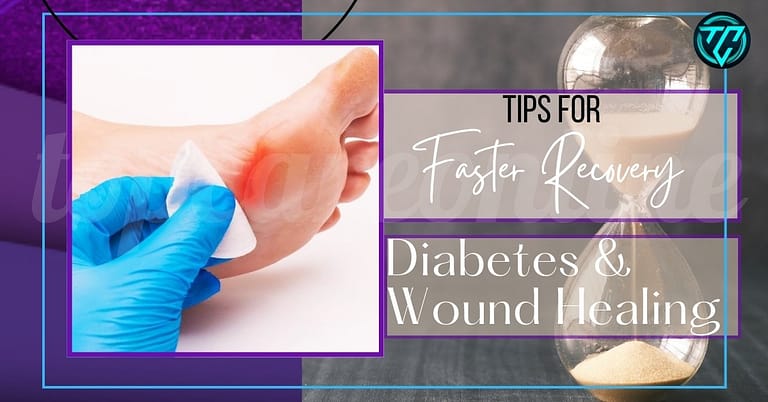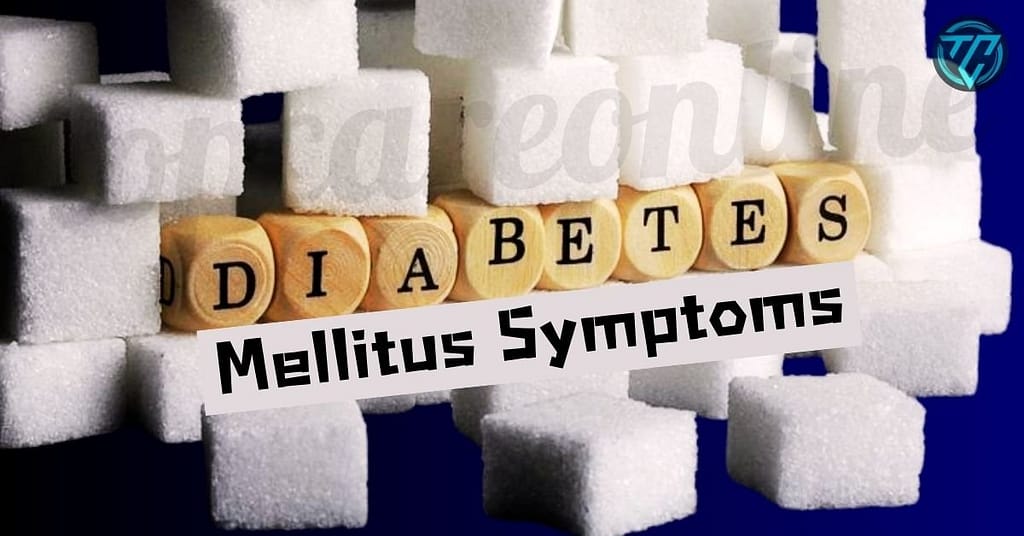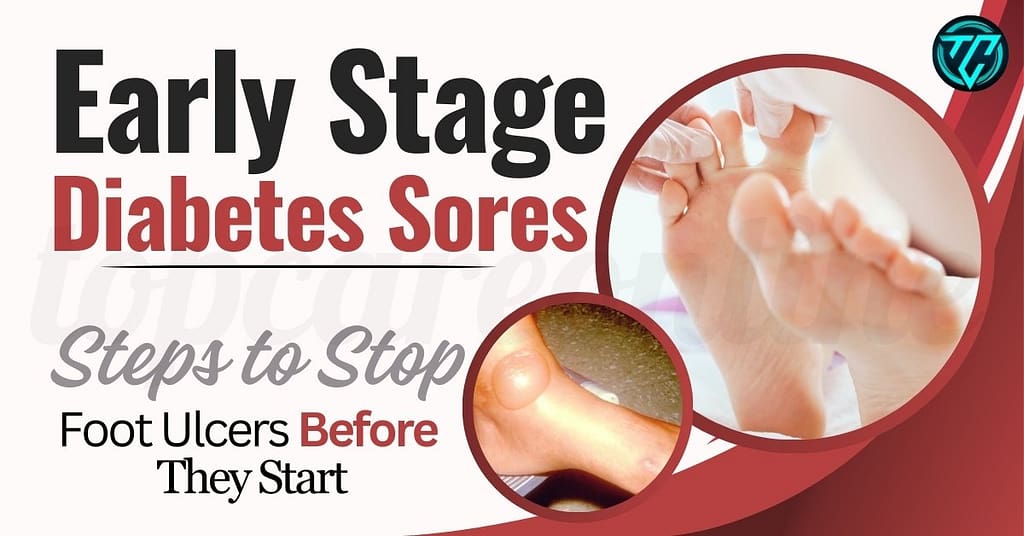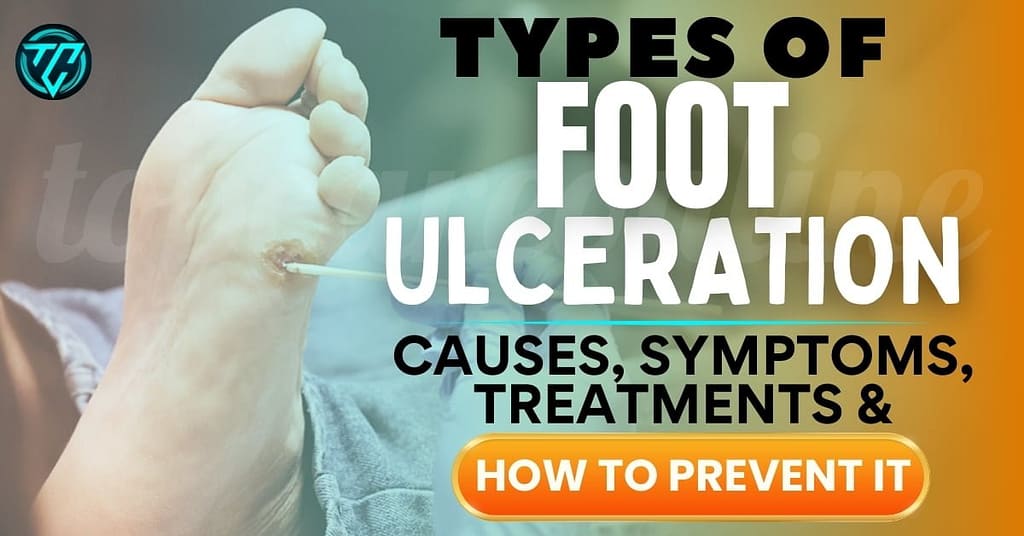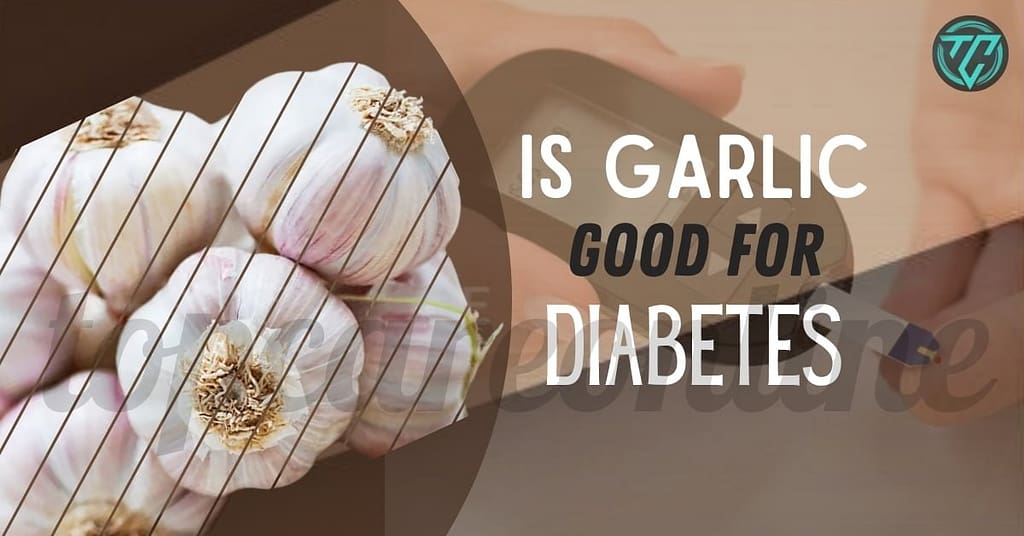Mellitus and Wound Healing | Type 2 Diabetes | Effect | Types | Natural Home Remedies | Treatment | After Surgery |
Managing diabetes involves more than just controlling blood sugar levels. One critical aspect that often requires attention is wound healing. For individuals with diabetes, wounds can take significantly longer to heal, leading to increased risks of complications. This comprehensive guide explores the intricate relationship between diabetes and wound healing,
Relation between diabetes and wound healing
Diabetes significantly affects wound healing due to impaired immune response, reduced blood circulation, and nerve damage. Elevated blood glucose levels can hinder white blood cell function and promote bacterial growth, increasing infection risk. Chronic inflammation also prolongs healing. Effective diabetes management, including lifestyle changes and regular monitoring, is crucial for improving wound healing and reducing complications.
Diabetes Mellitus and Wound Healing
Delayed Wound Healing in Diabetes Mellitus
In diabetes mellitus, delayed wound healing is caused by elevated blood glucose levels impairing the immune system, poor circulation from damaged blood vessels, reduced sensation due to nerve damage, and chronic inflammation. Effective blood glucose management is essential to improve healing and prevent complications.
Type 2 Diabetes Wound Healing
In individuals with type 2 diabetes, wound healing can be notably impaired due to several interconnected factors. Poorly controlled blood sugar levels can weaken the immune system, impair white blood cell function, and increase susceptibility to infections.
Additionally, diabetes can damage blood vessels, leading to reduced circulation and inadequate delivery of oxygen and nutrients to the wound site. Nerve damage associated with diabetes may result in reduced sensation, causing wounds to go unnoticed and untreated.
Chronic inflammation common in type 2 diabetes further complicates the healing process, prolonging recovery. Effective management of blood glucose levels through lifestyle changes, medication, and regular medical care is essential to improve wound healing and minimize complications.
The Effect of Diabetes on Wound Healing
How Diabetes Affects Wound Healing
Diabetes mellitus, both type 1 and type 2, affects wound healing through several mechanisms:
- Hyperglycemia: Elevated blood sugar levels can impede the body’s ability to heal wounds effectively. High glucose levels affect various cellular processes, including immune response and tissue repair.
- Reduced Circulation: Diabetes can lead to poor blood flow, which limits the delivery of essential nutrients and oxygen to the wound site.
- Immune System Impairment: Diabetes can weaken the immune system, making it harder for the body to fight infections and manage inflammation.
Why do Wounds take Longer to Heal in Diabetics
why do diabetics have problems with wounds? Delayed wound healing is a significant concern in diabetes management. Causes of Delayed Wound Healing in Diabetes include:
- Delayed wound healing in diabetes is primarily due to a combination of factors related to the disease’s effects on the body. Here are some key causes:
- Hyperglycemia: Elevated blood sugar levels can impair the normal function of various cells involved in wound healing, such as fibroblasts and macrophages. This leads to slower collagen formation and tissue repair.
- Impaired Immune Response: High blood glucose levels can weaken the immune system, reducing the body’s ability to fight infections and handle inflammation. This increases the risk of wound infections, which further delays healing.
- Reduced Blood Flow: Diabetes can lead to poor blood circulation due to damage to blood vessels (diabetic vasculopathy). This reduces the delivery of oxygen, nutrients, and immune cells to the wound site, slowing down the healing process.
- Neuropathy: Nerve damage from diabetes can reduce sensation in the extremities, making it harder for individuals to notice and promptly address injuries. This can lead to prolonged exposure of wounds to harmful conditions and increase the risk of complications.
- Increased Infection Risk: Diabetes can make the skin more susceptible to infections due to elevated glucose levels, which provide a favorable environment for bacteria to thrive. Infections can significantly delay wound healing.
- Altered Inflammatory Response: Diabetes can cause an abnormal inflammatory response, where inflammation is either prolonged or insufficient. Chronic inflammation can impair the healing process and prolong recovery time.
- Decreased Collagen Production: Collagen is a crucial protein for wound healing, and its production can be impaired in diabetes, leading to weaker and slower tissue repair.
- Poor Nutrition: Diabetes can sometimes be associated with poor nutritional status, either due to dietary restrictions or malabsorption issues. Adequate nutrition is essential for effective wound healing, and deficiencies can hinder this process.
- Dehydrated Skin: Diabetes can cause skin dryness and reduced moisture levels, making the skin less elastic and more prone to damage. This can complicate wound healing and make the skin less resilient.
Managing diabetes effectively through medication, diet, and lifestyle changes, along with proper wound care, is crucial for improving healing outcomes and reducing complications.
Types of Diabetic Wounds
Early Stage Diabetic Sores
Early-stage diabetic sores might appear minor but can quickly escalate if not properly managed:
- Minor Cuts and Scrapes: These can become problematic if they are not treated promptly, potentially leading to infections.
- Blisters: Often found on the feet, especially among those with diabetes who may wear ill-fitting shoes or have excessive moisture.
When to Seek Medical Help
- Persistent Sores: If the sore does not show improvement within a few days or seems to be getting worse.
- Signs of Infection: Redness, swelling, warmth, pus, or an increase in pain.
- Systemic Symptoms: Fever, chills, or feeling unwell, which might indicate a more serious infection.
Diabetic Wounds on Legs
Diabetic wounds on legs are particularly concerning due to their potential for serious complications:
- Leg Ulcers: These are chronic wounds that can be painful and slow to heal, often seen in individuals with poor circulation.
- Pressure Ulcers: Also known as bedsores, these occur due to prolonged pressure on specific areas, which can be exacerbated by diabetes-related mobility issues.
Foot Ulceration
Foot ulceration is indeed a severe form of diabetic wound and is a common complication for individuals with diabetes. Diabetic foot ulcers can significantly impact quality of life and may lead to more serious complications if not managed properly.
Foot ulceration is often caused by nerve damage, poor circulation, pressure, trauma, infection, and dry skin. To manage and treat diabetic foot ulcers effectively:
- Seek Medical Attention: Consult healthcare professionals for proper diagnosis and treatment.
- Blood Sugar Management: Maintain optimal blood glucose levels to support healing.
- Advanced Therapies: Consider treatments like hyperbaric oxygen therapy or negative pressure wound therapy if necessary.
Prevention Strategies:
- Inspect Feet Daily: Check for injuries or abnormalities.
- Proper Hygiene: Wash and moisturize feet regularly.
- Protective Footwear: Wear well-fitting, supportive shoes.
Proper treatment and preventive measures can significantly improve healing and reduce the risk of severe complications.
Strategies for Effective Diabetic Wound Care
what helps diabetic wounds heal faster
How Can a Diabetic Wound Heal Faster? To promote faster healing of diabetic wounds, consider the following strategies:
- Blood Sugar Control
- Maintain Optimal Blood Glucose Levels: Keeping blood sugar levels within a target range is crucial. This can be achieved through a balanced diet, regular exercise, and prescribed medications or insulin therapy.
- Regular Monitoring: Frequent monitoring of blood glucose levels helps in adjusting treatments as needed.
- Wound Care
- Clean Wounds Properly: Gently clean wounds with mild soap and water to prevent infection. Avoid using alcohol or hydrogen peroxide, which can be too harsh.
- Use Appropriate Dressings: Select dressings that promote a moist wound environment, which can enhance healing. Hydrocolloid or alginate dressings are often recommended.
- Apply Antiseptics Wisely: Use antiseptics that are suitable for diabetic wounds, and follow guidelines to prevent irritation and support healing.
- Infection Prevention and Management
- Monitor for Signs of Infection: Look out for redness, swelling, increased pain, or pus. If any signs of infection are present, seek medical attention promptly.
- Use Antibiotics if Needed: Follow your healthcare provider’s recommendations for antibiotics or other treatments if an infection is diagnosed.
- Supportive Care
- Keep the Wound Dry and Clean: Regularly change dressings and keep the wound dry to prevent maceration and infection.
- Avoid Pressure and Trauma: Protect the wound from additional trauma or pressure, which can exacerbate the problem.
- Healthy Lifestyle
- Eat a Balanced Diet: A diet rich in vitamins, minerals, and proteins supports tissue repair. Foods high in vitamin C, zinc, and protein are particularly beneficial for wound healing.
- Stay Hydrated: Proper hydration is important for maintaining skin moisture and overall health.
- Regular Exercise
- Engage in Appropriate Physical Activity: Exercise improves blood circulation, which can help in delivering nutrients and oxygen to the wound site. However, avoid activities that could aggravate the wound.
- Foot Care
- Inspect Feet Daily: For diabetic foot wounds, inspect feet daily for any signs of injury, and address any issues promptly.
- Wear Proper Footwear: Choose well-fitting, supportive shoes to reduce the risk of foot injuries.
- Medical Interventions
- Consult Healthcare Providers: Work with healthcare professionals, such as endocrinologists and wound care specialists, for personalized treatment plans and interventions.
- Consider Advanced Therapies: In some cases, advanced treatments like hyperbaric oxygen therapy, growth factor applications, or skin grafts may be recommended.
By combining these strategies, you can enhance the diabetes slow wound healing process and improve outcomes for diabetic wounds.
Natural Home Remedies for Diabetic Wounds
While medical treatment and proper management are crucial for diabetic wounds, some natural home remedies can complement professional care and help promote healing. Here are some natural remedies that might be beneficial:
1. Honey
- Why It Helps: Honey has natural antibacterial and anti-inflammatory properties, which can help reduce infection risk and promote healing.
- How to Use: Apply raw, medical-grade honey directly to the wound and cover it with a sterile dressing. Change the dressing and reapply honey regularly.
2. Aloe Vera
- Why It Helps: Aloe vera has soothing, moisturizing, and anti-inflammatory properties that can aid in wound healing.
- How to Use: Apply fresh aloe vera gel from the plant directly to the wound. Cover it with a clean dressing and change it regularly.
3. Turmeric
- Why It Helps: Turmeric contains curcumin, which has anti-inflammatory and antimicrobial properties.
- How to Use: Create a paste by mixing turmeric powder with a little water or honey. Apply this paste to the wound and cover it with a clean dressing. Be cautious with turmeric as it can stain the skin and clothing.
4. Coconut Oil
- Why It Helps: Coconut oil has antibacterial properties and helps keep the wound moisturized.
- How to Use: Apply virgin coconut oil to the wound and cover it with a clean dressing. Reapply as needed.
5. Garlic
- Why It Helps: Garlic has antimicrobial properties and can help in fighting infections.
- How to Use: Crush fresh garlic and mix it with a carrier oil (like coconut oil). Apply the mixture to the wound. Be cautious with garlic as it can be irritating to the skin.
6. Green Tea
- Why It Helps: Green tea contains antioxidants and anti-inflammatory compounds.
- How to Use: Brew green tea, let it cool, and use a clean cloth to apply the tea to the wound. Alternatively, you can use green tea extracts or infusions in wound dressings.
7. Oregano Oil
- Why It Helps: Oregano oil has strong antimicrobial properties.
- How to Use: Dilute oregano oil with a carrier oil (like olive oil) before applying it to the wound. This can help prevent infection and support healing.
8. Epsom Salt
- Why It Helps: Epsom salt can help reduce inflammation and draw out impurities.
- How to Use: Dissolve Epsom salt in warm water and soak the affected area. This can help clean the wound and reduce swelling.
9. Apple Cider Vinegar
- Why It Helps: Apple cider vinegar has antimicrobial properties and can help clean the wound.
- How to Use: Dilute apple cider vinegar with water (usually 1 part vinegar to 2 parts water) and use it to gently cleanse the wound.
10. Calendula
- Why It Helps: Calendula has anti-inflammatory and antimicrobial properties.
- How to Use: Apply calendula ointment or cream to the wound. Be sure to use a product that is suitable for topical use.
Precautions:
- Consult Your Healthcare Provider: Before trying any home remedies, discuss them with your healthcare provider, especially if you have a serious or chronic wound.
- Avoid Allergic Reactions: Test a small amount of any remedy on a different part of the skin first to ensure you don’t have an allergic reaction.
- Monitor for Infections: If you notice any signs of infection (increased redness, swelling, pus, or pain), seek medical attention promptly.
While these remedies can support wound healing, they should not replace professional medical treatment and proper diabetes management.
Treatment for Diabetic Wound Infection
Infections can complicate diabetic wounds, making timely treatment essential:
- Antibiotics: Both oral and topical antibiotics may be necessary, as directed by a healthcare provider.
- Wound Debridement: Removing dead tissue can facilitate better healing and prevent infections.
Diabetes Wound Healing After Surgery
Post-surgical wound care in diabetic patients requires meticulous attention:
- Adhere to Post-Operative Instructions: Follow the healthcare team’s guidelines for wound care and management.
- Monitor for Complications: Watch for signs of infection or delayed healing, and consult your healthcare provider if concerns arise.
Whether you’re dealing with early-stage diabetic sores or more severe conditions like foot ulcers, proactive care and maintaining good blood sugar control are key to successful wound healing.
For personalized advice and treatment plans, consult with your healthcare provider to ensure effective wound management and overall health improvement. Taking proactive steps in wound care can make a significant difference in achieving better outcomes and enhancing your quality of life.

